
Fiber art refers to fine art whose material consists of natural or synthetic fiber and other components, such as fabric or yarn. It focuses on the materials and on the manual labor on the part of the artist as part of the works' significance, and prioritizes aesthetic value over utility.
Miriam Nathan-Roberts was a textile artist who specialized in Studio Art Quilting. Her work was centered on abstract "illusions of three dimensions on flat or semi-flat surfaces." Nathan-Roberts received many awards at the Quilt National over the years, including Best in Show, the People's Choice Award (1985), and the Juror's Award of Merit (2013); she served as Juror in 2005.
Quilt art, sometimes known as art quilting, mixed media art quilts or fiber art quilts, is an art form that uses both modern and traditional quilting techniques to create art objects. Practitioners of quilt art create it based on their experiences, imagery, and ideas, rather than traditional patterns. Quilt art generally has more in common with the fine arts than it does with traditional quilting. Quilt art is typically hung or mounted.

The San Jose Museum of Quilts & Textiles is an art museum in Downtown San Jose, California, USA. Founded in 1977, the museum is the first in the United States devoted solely to quilts and textiles as an art form. Holdings include a permanent collection of over 1,000 quilts, garments and ethnic textiles, emphasizing artists of the 20th- and 21st-century, and a research library with over 500 books concerning the history and techniques of the craft.
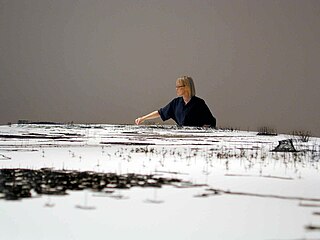
Anne Wilson is a Chicago-based visual artist. Wilson creates sculpture, drawings, Internet projects, photography, performance, and DVD stop motion animations employing table linens, bed sheets, human hair, lace, thread and wire. Her work extends the traditional processes of fiber art to other media. Wilson is a professor in the Department of Fiber and Material Studies at The School of the Art Institute of Chicago.
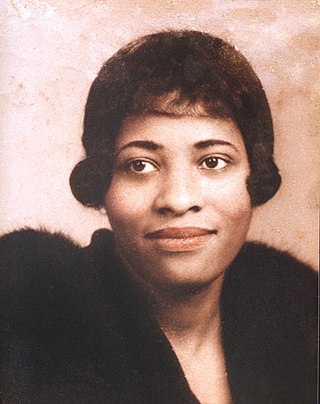
Rosie Lee Tompkins (1936–2006) is the art pseudonym of Effie Mae Martin Howard, a widely acclaimed African-American quiltmaker and fiber artist of Richmond, California. The New York Times called her "one of the great American artists," and her work "one of the century’s major artistic accomplishments." More than 500 works by Tompkins reside at the Berkeley Art Museum and Pacific Film Archive.

Adela Akers was a Spanish-born textile and fiber artist residing in the United States. She was Professor Emeritus at the Tyler School of Art. Her career as an artist spans the "whole history of modern fiber art." Her work is in the Renwick Gallery, the Metropolitan Museum of Art and the Museum of Art and Design. Her papers are at the Archives of American Art.
Polly Barton is an American textile artist.
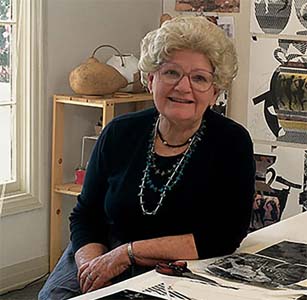
Katherine Westphal was an American textile designer and fiber artist who helped to establish quilting as a fine art form.
Women of Color Quilters Network (WCQN) is a national organization dedicated to preserving African American quiltmaking.
Wini "Akissi" McQueen is an American quilter based in Macon, Georgia. Her artistic production consists of hand-dyed accessories and narrative quilts. Her techniques for her well-known quilts include an image transferring process. In her work, she tackles issues of race, class, society, and women. Her quilts have featured in many museum exhibitions, including the Museum of African American Folk Art, the Taft Museum, the Bernice Steinbam Gallery, and the William College Art Museum. In 2020, her quilts were featured in a retrospective dedicated to her textile art at the Museum of Arts & Sciences in Macon, GA.
Sabrina Gschwandtner is an American artist currently living in Los Angeles, California. She has held numerous showings of her work throughout the country and several pieces have been acquired by museums, including LACMA, the Smithsonian American Art Museum, the Museum of Fine Arts, Boston, and the RISD Museum.
Therese May is an American artist who was an early participants in the art quilt movement that began in the 1960s. She is known for her mixed media quilts and is featured in several contemporary quilting histories.

Jean Ray Laury was an American artist and designer. She was one of the first fine artists to move to quilting as a medium of choice in the late 1950s. Her quilts followed neither traditional method nor pattern; they were bold, modern, colorful collages, often laced with humor and satire. Penning over twenty books and teaching over 2,000 workshops, Laury helped women see the creative possibilities in everyday objects and awake their sense of inspiration. Laury has been called a "foremother of a quilt revival", and "one of the pioneers" of non-traditional quilts.

Jane Dunnewold is an American textile artist and author. She was previously the president of the Surface Design Association.
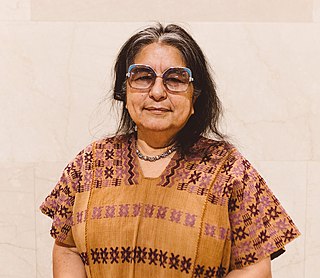
Consuelo Jiménez Underwood is an American fiber artist, known for her pieces that focus on immigration issues. She is an indigenous Chicana currently based in Cupertino, California. As an artist she works with textiles in attempt to unify her American roots with her Mexican Indigenous ones, along with trying to convey the same for other multicultural people.
Joan Schulze is an American artist, lecturer, and poet. Schulze's career spans over five decades: she is best known for her work of contemporary quilts, fiberarts, and collage. Schulze has been named a “pioneer of the art quilt movement,” and her influence has been compared to that of Robert Rauschenberg’s. Her work is in galleries and private collections worldwide including the Renwick Gallery/Smithsonian Institution in Washington DC, the Museum of Arts and Design in New York, & the Oakland Museum of California.
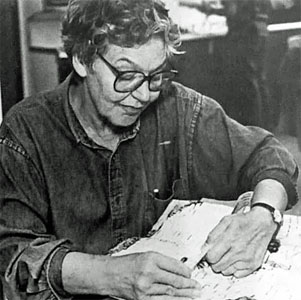
Lillian Elliott was an American fiber artist, and textile designer. She is known for her innovative basket craft.

Linda Gass is an American environmental activist and artist known for brightly colored quilted silk landscapes, environmental works, and public art sculptures, which reflect her passion for environmental preservation, water conservation and land use.
Mary Balzer Buskirk was an American textile artist known for being part of the Mid-century modern movement creating fiber art outside the applied textile tradition.











